

|
, Lace doilies knit by Ava Coleman
|
Tweet
|
|
|
|
|
|||
What a Tangled Web We Weave: Did Lace
Knitting Originate in Spain? Some knitting traditions are famous around the world, while others, just as interesting and beautiful, are less celebrated outside of their local areas. Such is the case with knitting in Spain. Spanish Origins
Legend holds that Fair Isle knitting, one of the most famous knitting traditions in the world, was first brought to Scotland by sailors shipwrecked from the Spanish Armada. Looking at the intricate colorwork in early Spanish knitting, it's not difficult to imagine how this might have happened. Today, however, most knitting historians believe that Fair Isle knitters were influenced by the colorful designs on mittens and socks from the Baltic countries of Estonia, Latvia, and Lithuania. Interestingly, one of the most popular designs used in knitting Lithuanian socks and mittens features a lattice outlining floral motifs that is almost identical to the lattice designs on the early Spanish pillows.
Lace
It is possible that lace knitting was invented in Spain in the eleventh or twelfth century. Both James Norbury and Barbara Walker include the two stitch patterns that I've used in my mantilla pattern, the Madeira Mesh and the Madeira Leaf Border, in their stitch libraries and surmise that they are, perhaps, some of the oldest lace patterns in existence. Silk stockings were said to be knitted in Spain in the twelfth century, and were later imported to England by both King Henry VIII and Queen Elizabeth I. Although I've seen eleventh and twelfth century dates mentioned in many articles, I haven't been able to track down specific examples of lace knitting from this period or any original studies of lace knitting made this early. Whatever its origin, knitted lace has been popular throughout Europe for a very long time. In the northern countries, woolen shawls and stoles were the most common lace products, made for warmth and to sell as an extra source of income. In southern Europe, lace was knit more for decoration, perhaps by upper-class ladies who had more leisure time, and definitely by knitters who lived in warmer climates and didn't need the insulating winter garments worn by their neighbors to the north. In the nineteenth and twentieth centuries, the most popular knitted lace items in Spain have been circular cotton doilies, shawls made out of wool using the same doily patterns, and mantillas (the head scarves worn by women in Roman Catholic church services).
Montse Stanley, a knitting historian and author who was born in Barcelona, Spain, was driven to learn, write and teach about knitting when she found out how little was known about the knitting in the Catalan region of her country. She wrote several knitting books including the bestselling title, The Handknitter's Handbook (David & Charles, 1986, 1990, 1993; Reader's Digest, 1993), as well as over 80 articles about knitting. In one article featured in Threads magazine, Stanley recalls the many lace doilies, or mats, that she saw as a child. Wanting to know more about where these designs came from, she asked some knitters in the area and was surprised to discover that one of her favorite Catalonian designs was actually worked from a pattern in a German knitting booklet!
The Catalonian and German doilies and the shawls inspired by them were finished off with a crochet chain bind off that added an edging of small picots to the design and made blocking the curved shapes quite easy. Here's How 1. Insert a crochet hook into the next few live stitches on the knitting needle. Your pattern will tell you how many stitches to work together. In this example, I am working 3 stitches together.
2. Pull the working yarn through the live stitches with the crochet hook and drop them off of the knitting needle.
3. Pull the working yarn through the 2 stitches on the crochet hook so only 1 stitch remains on the hook.
4. Make 5 chain stitches. Repeat steps 1-4 as needed, then join the end of the last chain to the work with a crochet slip stitch, cut the yarn and pull the tail through the last loop to fasten off. Learn More
|
|||
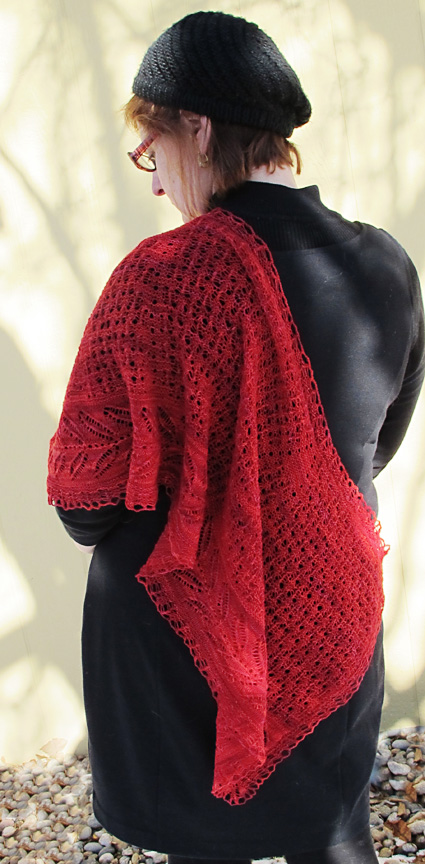 |
by Donna Druchunas In her article Catalan Knit Lace in Threads Magazine, knitting author and historian Montse Stanley mentions women knitting shawls in the same designs used for doilies and mats. Inspired by her thoughts, I've used traditional Spanish lace stitches to design this mantilla, which I wear over my shoulders rather than as a head covering. This mantilla is worked back and forth in rows from the neck down, with increases at the two shoulders to create a better fit and drape than is possible with a straight rectangular stole. After the shaping is complete, a wide border is knitted, then stitches are picked up around the entire piece and the edging is worked from the center out in the round. |
|
SIZE |
|
|
|
MATERIALS Notions |
| GAUGE |
Approx 22 sts and 28 rows = 4 inches over
Madeira Mesh stitch, after blocking |
|
PATTERN NOTES |
Be VERY careful working the p3tog and p2tog tbl stitches as it is quite easy to miss a loop and drop a stitch while working these decreases. Check your work carefully before wetting and blocking and secure any dropped stitches as you weave in the ends so they do not run when you stretch the piece to block it. To secure a dropped stitch from a decrease, use a tapestry needle to thread a 6-inch piece of yarn through the dropped stitch and pull it through the back of the decreases to which the stitch should belong, on the WS. Tie a square knot, which will be hidden by the decrease, and weave in the tails. Trim the ends after blocking. Both Spanish lace stitch patterns used are featured in Barbara Walker's First Treasury and James Norbury's Traditional Knitting Patterns. I've charted the patterns, and created a circular version of the mesh pattern to use as an edging on this mantilla. For the increases before the Border, use your favourite. Placement
and type of increase doesn't matter, as it's hidden in the
garter stitch. |
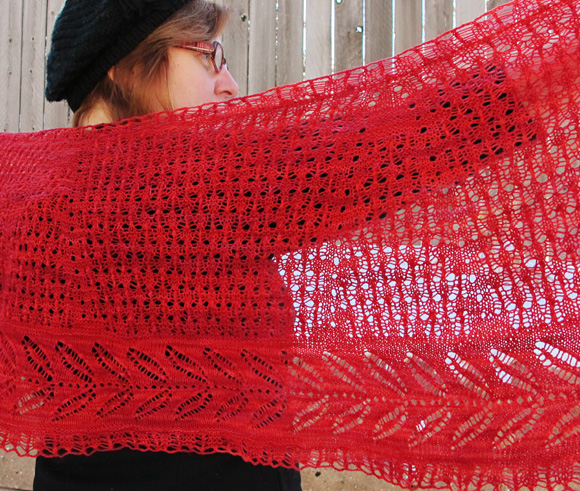
|
|
DIRECTIONS |
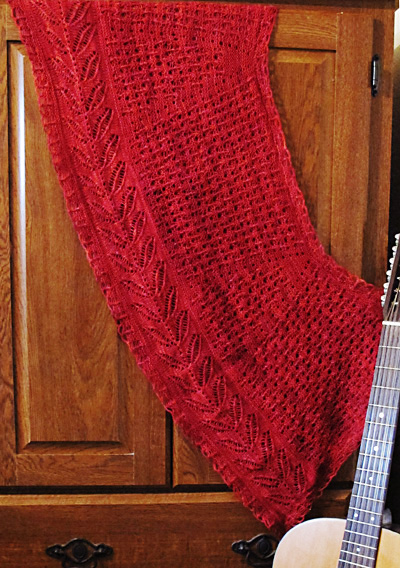 Setup row [WS]: [K61, pm, k1, pm] twice, k61. Body Work in pattern as set, increasing every 1st and 7th row, until you have 13 sts between markers, ending after a full repeat of the Madeira Mesh is complete. 209 sts. Note: As you work the following rows, take the increased sts
into the Madeira Mesh pattern. Row 7 [RS]: Rep Row 1. Work in pattern as set, increasing every 1st and 7th row, and taking the increased sts into the Madeira mesh pattern, until you have 35 sts between markers, ending after a full repeat of the Madeira Mesh is complete. 253 sts. 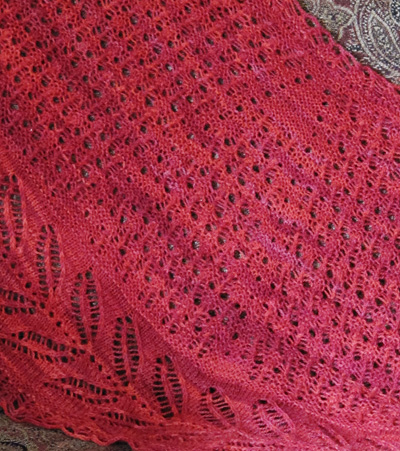 Knit 3 rows. Increase row [WS]: K19, [m1, k18] 13 times. 266 sts. Row 1 [RS]: K2, pm, work Madeira
Leaf Border chart across next 264 sts, pm, k2. Edging Setup [RS]: Knit across. Do not turn, (pm, m1 with backwards-loop CO at corner, pm), pick up and knit 79 sts across side of piece; (pm, m1, pm) at next corner; pick up and knit 181 sts across CO edge; (pm, m1, pm) at next corner; pick up and knit 79 sts across other side of piece, (pm, m1). Join to work in the round, placing a contrasting color marker for beginning of round. 608 sts. Edging round: [Work Madeira Mesh Circular pattern
to first corner marker, work Edging Corner chart between corner
markers] four times. BO with crochet chain bind-off as follows: *Insert hook into 2 live sts on knitting needle and make 1 sc, *chain 5, make sc in next 3 live sts together; rep from * to last 2 sts on side, chain 5, make sc in next 2 live sts together, (chain 5, make sc into next 3 sts together) five times for corner, chain 5. Repeat from * three more times. Join with a slip st. Bind off. FINISHING Wash and block to finished dimensions as follows: Soak in tepid water (with no-rinse wool-wash soap if desired) until saturated. Squeeze out excess water by rolling the mantilla in a towel and stepping on it (do not wring). Place mantilla on blocking board, and pin in place by putting one pin in each crochet chain space and pulling gently away from the edge of the piece with the pin to open up the point. Do not over stretch the mantilla. You want the garter stitch to maintain its texture.
|
| ABOUT THE DESIGNER |
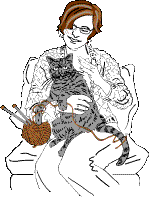 Visit Donna's website at sheeptoshawl.com. |
| Pattern & images © 2011 Donna Druchunas. Contact Donna |